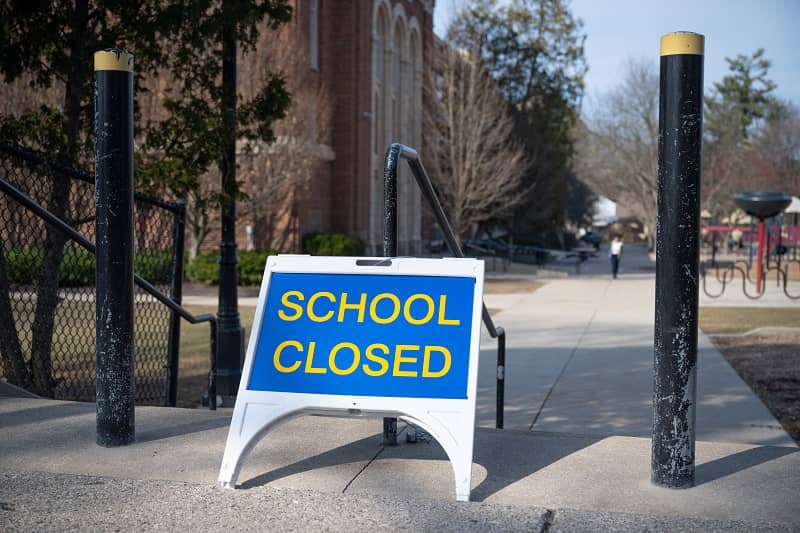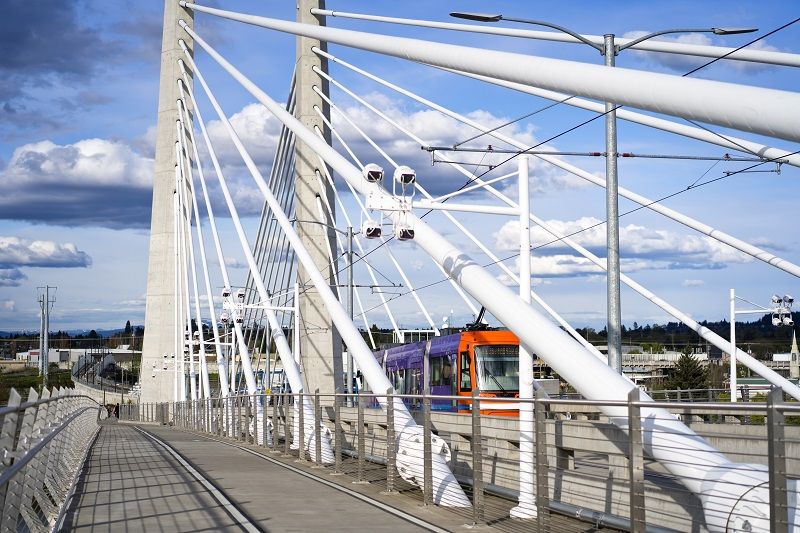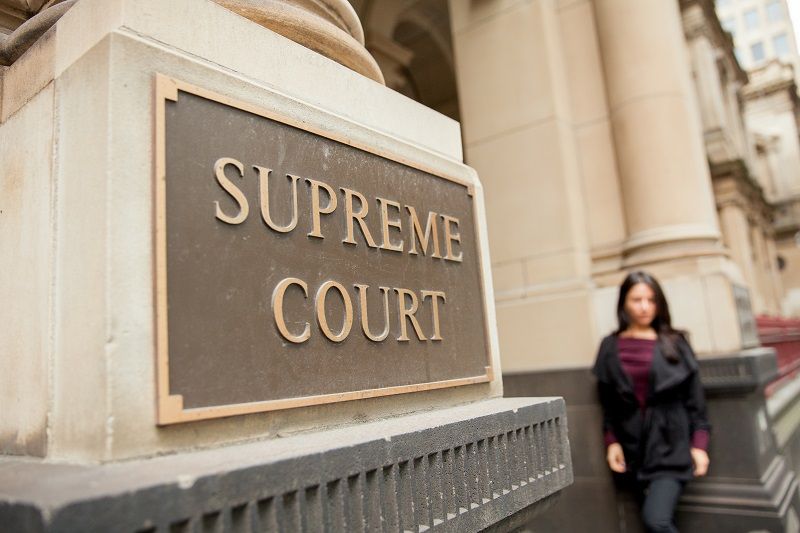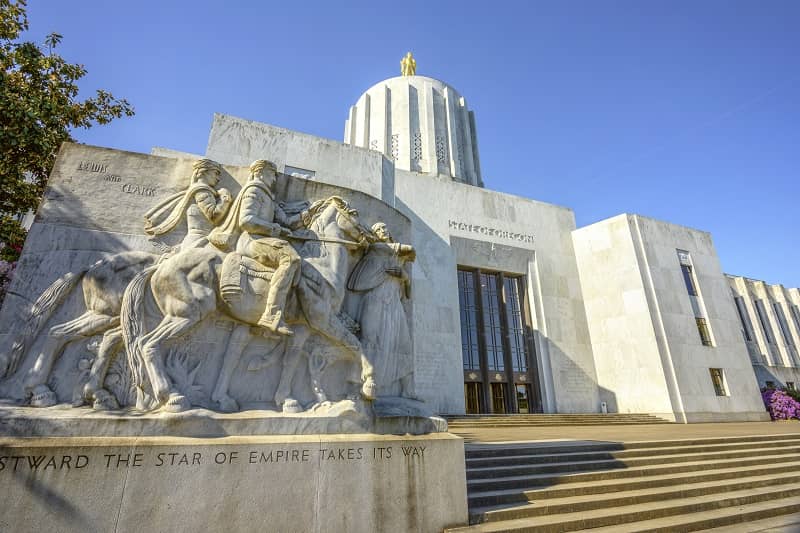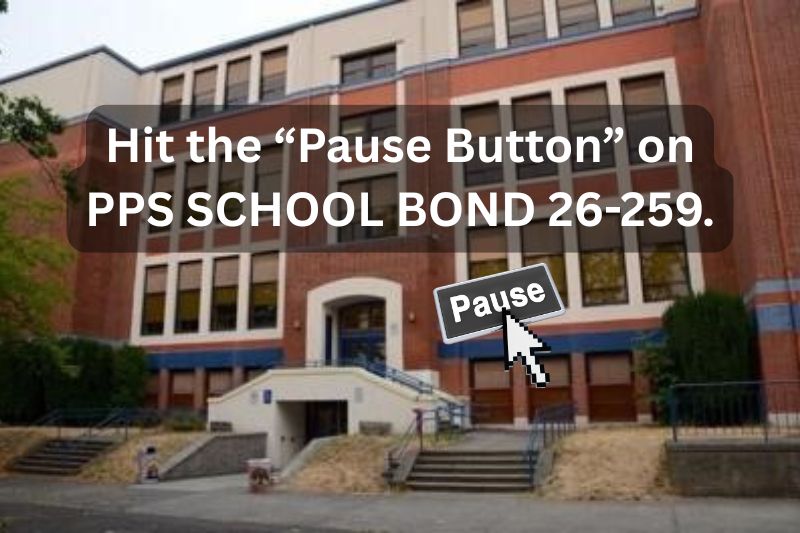John A. Charles, Jr.
President and CEO
May 5, 2025
Re: PPS 2025 Bond Measure 26-259
Cascade Policy Institute is a non-partisan, policy research organization based in Portland. Education policy is one of our primary areas of research.
Cascade has closely watched the evolution of the PPS bond measure over the past 18 months and testified on multiple occasions. We believe that PPS board members have failed to conduct appropriate due diligence on projects and that the bond itself does not comply with Oregon budgeting laws.
We recommend that the TSCC refuse to certify the bond budget or certify it “with objection.” Our testimony below outlines the basis for this request.
Failure to provide essential budget details
PPS admits that the bond principal will be a maximum of $1.83 billion, but how the money will be spent is largely a mystery.
For example, the largest category of spending, school modernization, lists a total of $1.1 billion in expenditures, but no commitments related to the three specific high school rebuilds: Jefferson, Ida B. Wells, and Cleveland. Since November, PPS management has promised to reduce the costs of those schools in order to increase the amount available for elementary and middle schools, but has been unable to provide details.
At the Board meeting on December 3, 2024, the Board took testimony from Jan Watt, a retired educator who spent 56 years at Cleveland High School. She told the board, “Your goal was to meet on January 7 to vote on the final wording of the May bond. But you won’t have revised designs and cost estimates that voters will need to know by January 7.”
Later in that same meeting, PPS Superintendent Dr. Kimberlee Armstrong stated, “We don’t know the hard or soft cost of the modernization projects and won’t know for months and months.”
Dan Jung, district COO, said at the December 17 work session, “The 2025 bond is unique in that much of the scope of work is not defined.”
At the March 4 meeting, Director Julia Brim-Edwards said, “Cost updates should have been done in January. Releasing them in May after voters will have already received their ballots is way too late.”
In mid-April Joanna Hou of Willamette Week wrote, “The April 8 meeting of the PPS Board featured an unusual sight: Three weeks before May ballots were to land in voters’ mailboxes, board members squabbled about what would be included in the district’s construction bond.”
In that same article, political consultant Lis Kaufman told Ms. Hou that the way the bond was written, “Nobody knows how much money they’re passing or saving.”
In early May, Dan Jung told Julia Silverman of The Oregonian, “Bottom line price estimates for the high schools won’t be known until this summer.”
In the 2020 bond, PPS included specific allocations for the two headliner projects: Jefferson High School, budgeted for $311 million, and the Center for Black Student Excellence (CBSE), for $60 million. That level of specificity helped give voters the confidence to approve the measure.
Unfortunately, making those commitments has proven to be embarrassing for the District, since neither project was built and very little of the bond money was spent. It now appears that Board members have learned the wrong lesson. Instead of focusing on better execution, they are simply avoiding any commitments in the 2025 bond.
Without specificity, it is not actually a budget.
Failure to disclose expected interest payments on the bond
The most important fact about any general obligation bond proposal is the total cost of paying off principal and interest. Many voters do not understand that a bond is a debt instrument, and servicing that debt requires new property taxes in the future.
PPS has withheld this information from the public.
During 2024, consultants to the Board developed scenarios regarding bond principal amounts, maturity dates, and interest levels. On the last such report presented to the Board on December 2, there were two estimates of debt service for a bond principal amount of $1.8 billion, labeled E.1 and E.2.
Under E.1, the estimated total interest was $1.7 billion, nearly equal to the principal. Under E.2, the estimated interest was $800 million.
In subsequent meetings, the Board never discussed debt service. The subject is also not mentioned in the Voters’ Pamphlet. To voters who don’t understand how debt service on a GO bond works, it appears that the liability for taxpayers in the future is $1.83 billion, which is far below the total cost.
Cascade Policy Institute filed a Public Records Request with the district on April 24th asking what the estimated interest payments will be for the bond. On April 30th the district provided the following answer:
The District has not yet endorsed either of these specific scenarios. For context the selection will be dependent on variables including the issue amount of each tranche, the timing and amounts of additional issuances, and when the next ballot is approached. It is always our priority to minimize the repayment period and interest expense for each issue within the above parameters. We take seriously our responsibility to be a good steward of public dollars.
While we appreciate the fact that there are multiple variables involved in determining the level of interest, for the Board to say that predicting the future is difficult so voters should be given no estimate of debt service is disingenuous.
There is good reason for voters to be skeptical about this because PPS lowballed the cost of school modernization in the 2017 bond. As outside auditors later confirmed, the PPS staff reduced the estimated cost of construction by $98 million without any defensible methodology, apparently to curry favor with voters. This forced the district to later add costs to the 2020 bond.
At the January 7th public hearing on the bond, the only person who brought up debt service was PPS parent Rob Galanakis, who is also running for a seat on the PPS board. His testimony summarized the problem that a $1.83 billion bond will pose in the future:
This bond would require a 32-year authorization and interest of $1.7 billion. The total debt service will be $3.5 billion, with nearly 50% going to banks, not schools. We’re asking future PPS board members to be more financially responsible and generous than we’re willing to be ourselves. If this bond goes forward in May, we will have a choice of voting ‘no’ to underfund our schools today, or voting ‘yes’ and underfunding our schools in the future.
The fact that this critical issue has been brought up by a school board candidate but not the school board itself suggests that board members don’t want voters to be fully informed about
the total cost of the bond.
Failure to undertake due diligence
The most basic requirement of every school board member is to ensure proper due diligence on major financial transactions. According to the website Investopedia, this means:
Due diligence is an investigation, audit, or review performed to confirm facts or details of a matter under consideration. In the financial world, due diligence requires an examination of financial records before entering into a proposed transaction with another party.
Due diligence is primarily a way to reduce risk exposure. The process ensures that a party is aware of all the details of a transaction before they agree to it.
For more than a year, Board members have shown little interest in confirming facts or details of planned bond expenditures. Perhaps the most obvious example is the way the Cornerstone Management report was handled.
The Cornerstone team was brought in last October to determine why the three planned PPS high school modernization projects — Cleveland, Wells and Jefferson — had budgets that were so far above comparable schools elsewhere. Cornerstone used the recently completed Lincoln High School in Portland and the partially completed Beaverton High School for benchmarking. This was a useful exercise and should have helped PPS Board members with their due diligence.
However, when the draft bond language was placed before the PPS Board on January 7, the Cornerstone report had not yet been distributed. The Board proceeded to refer the bond anyway, even though the deadline for referral was not until February 28.
At the February 4 meeting when the Cornerstone report was finally discussed, Board member Julia Brim-Edwards admitted, “This is a super important discussion that should have happened before the bond was referred.”
The fact that the Board voted without reviewing the Cornerstone report shows that either Board members don’t understand due diligence, or they don’t care.
Dan Jung summarized the Cornerstone findings which indicated that the cost drivers over which PPS had control included “climate policy, the square footage of schools, teen parent centers and health clinics, and the business equity in contracting policy.”
Knowing this, the Board should have had a detailed discussion of the tradeoffs associated with these variables. But that never happened. Board members decided they liked all of these things, so they were unwilling to make any significant changes.
They did agree to slight reductions in the size of the new schools, but the cost savings were trivial.
Several of the cost drivers merit additional discussion.
Square footage of new high schools
Since the PPS Board embarked on its campaign to rebuild or modernize school facilities in 2012, it has relied on a detailed set of Educational Specifications (“ed specs”) to guide school designs.
According to the ed specs, PPS high schools are supposed to be built for 1,700 students. But district enrollment has declined by nearly 11% since 2020, with most of the losses coming from elementary schools. This has serious implications for high school enrollment.
The newly-opened Benson only has 890 students, which makes it half-empty. The next school in the pipeline is Jefferson, which only has 459 students and has never had more than 1,000 over the past 25 years. It is forecasted to have 390 in the 2027-28 school year.
Cleveland high school only has 1,425 students today and this is likely to drop closer to 900 over the next decade. Ida B. Wells may only have around 1,260 students by the mid-2030s.
The district is building high schools for 15,300 students while projections say the district will have about 10,700 by 2039. Scott Bailey, a PPS board member from 2017-2021, testified at the March 4 board meeting and addressed this issue:
You are planning high schools for 15,300 students when you will only have about 11,000 in ten years. That’s a huge overbuild that will waste hundreds of millions of dollars. School closures will be inevitable. If you refer this to the ballot I will oppose the bond and fight it.
The Board has refused to consider either current enrollment or forecasts. As soon as the issue of square footage was raised in the discussion of the Cornerstone Report on February 4, Board member Michelle DePass quickly laid down a marker: “If we use current enrollment numbers, Jefferson gets harmed, so we should not consider enrollment as a factor.”
There was no further discussion of reducing school size.
Other states take a more rigorous approach. For example, the New Hampshire Department of Education’s 2024 Manual for Planning and Construction of School Buildings includes the following guidance:
- Baseline square footage determined by enrollment projections: The projected enrollment shall be the maximum published value in the 5-year projection using a statistically valid process.
PPS climate policy
PPS has never published an estimate of how much it will cost to implement the district’s all-electric building policy, but the Cornerstone report estimated that it will add roughly $10 million per school for the three remaining high schools. Since receiving that report, the Board has refused to discuss what the district would get for such a premium.
The answer is, “not much.”
PPS will buy its electricity from PGE at the three new high schools. As the attached summary from the City of Portland shows, in 2021 PGE relied on fossil fuels for 61% of its electricity generation. Prohibiting the use of natural gas in schools will simply move the gas consumption to somewhere else.
PPS school designers have stated that this problem will be solved by the Oregon legislative mandate that requires PGE and PacifiCorp to remove all “greenhouse” gases from their systems by 2040, but the two utilities have made it clear there is no way that can happen with known technologies. The electrical grid has certain engineering requirements, and mere political mandates cannot change the underlying physics.
Moreover, state law requires that all three high schools have backup diesel generators on site, so the all-electric policy can’t be implemented.
Oregon’s Green Energy Technology (GET) 1.5% mandate
The GET requirement was enacted by the state legislature in 2007 and requires most public bodies spending more than $5 million on new construction or building renovation to spend 1.5% of the budget on “green energy” technologies. The choices include woody biomass, geothermal, and solar (or solar paired with batteries), but most public bodies opt for solar arrays.
This has been expressed in PPS communication as a state “requirement”, but it is not. At least four school districts – Fern Ridge, Lane, South Lane and McMinnville – have elected to opt out, due to the high cost. According to information filed with Oregon Department of Energy (ODOE):
The Lane District’s design engineers have reviewed the project and have calculated that a simple payback would be over 20 years. With this information, the district has decided that an expenditure for this system would not be a prudent use of taxpayers’ money.
In 2022 the Bend-LaPine school district also declined to spend 1.5% of the construction budget on GET for the district’s addition to the high school, on the grounds that it was not cost-effective.
According to ODOE, the determination as to whether GET is appropriate or inappropriate is made by the local public body. If the entity cannot find an acceptable project, the 1.5% cost premium is deferred to the next project, if state money is being used. Since the PPS construction program is being funded primarily through local bond measures, this requirement would likely not apply, and the District could defer costs indefinitely.
Recent history suggests that local taxpayers are being taken advantage of by GET installations. At Lincoln High School, the District spent $1.09 million on GET, and the solar array generates electricity with an annual value of roughly $30,000. That means the project might pay for itself in 36 years, a period longer than the lifespan of the equipment itself.
For McDaniel, the District spent $2.14 million on a GET project, which produces electricity valued at $33,000 annually. The simple payback period will take 65 years.
For Benson, the district spent $3.18 million and expects to receive annual energy benefits of $50,206. This works out to a simple payback period of 79 years.
Now the design team plans to spend $6.1 million on a GET project at Jefferson, and the 1.5% premium will be only slightly less at Wells and Cleveland.
The GET law is a classic unfunded mandate from the legislature. If the PPS Board wants to add $20 million back to the bond construction budget, it should simply refuse to comply. Other school districts have shown that it’s possible. If PPS wants to demonstrate that the district is a good steward of public funds, it should publicly state that it will not waste taxpayer money on GET.
Between the meaningless “climate” policy and the GET mandate, at least $50 million is available to PPS if Board members simply decide to spend the money on other projects such as earthquake resilience.
Failure to provide for public participation in the bond’s development
The PPS bond was drafted through monthly meetings of a board committee during January-June of last year, with additional committee meetings during October-December. While public testimony was allowed at those meetings, it was not encouraged.
The only formal public hearing was a one-hour meeting held on January 7, 2025, just before the board meeting where bond approval was scheduled. The fact that the board planned to vote on bond referral the same night as the hearing meant that there would be no time for board members to consider public comment in a meaningful way.
Board members were aware of this problem before January 7th. As long-time Board member Julia Brim-Edwards said at the board work session on December 17:
Unlike any of our other past bonds, we’ve had no community forums to hear from the community. Even tonight, there is no opportunity for people to provide public comments. This is the first bond we’ve had that doesn’t have a stakeholder committee that meets in advance to give us a recommendation.
She reiterated her concern at the board meeting held February 4, 2025:
I’ve been involved with six PPS bonds. This is the bond with the least number of meetings, the least amount of public comment, the least information, and no community stakeholder group. We can’t keep shutting down discussion.
In contrast, the Metro regional government has been discussing a much smaller bond ($88 million for transit projects) for over a year and recently concluded a 45-day public comment period. Later this year the bond will be considered by the Metro Council, with additional opportunities for public input.
The PPS bond is the largest school bond in state history. As such it should have had a stakeholder committee from the beginning, and many rounds of public comment in order to properly vet the projects under consideration. The board had ample opportunities to do this in early 2025, since the deadline for bond referral was February 28. The board was aware of this yet chose to refer the measure on January 7.
Since January 7 the Board has had many conversations about key elements of the bond, continuing with a draft resolution on the board agenda for May 6 related to earthquake resiliency. These are all too late. The measure that people will vote on is already in mailboxes, and nothing that has been discussed since January 7 will change that.
Conclusion
PPS board members are trustees of the system, and as such have many legally binding responsibilities:
- A duty of undivided loyalty to beneficiaries;
- A duty to exercise reasonable care and skill in managing the enterprise; and
- A duty to use reasonable care to prevent breach of the trust by co-trustees.
It is basic trust law that a trustee must prudently manage trust property and ensure that funds are managed in a way that will benefit all trust beneficiaries. The standard of care, diligence, and skill required of a trustee is that of “an ordinarily prudent person in the conduct of his or her private affairs under similar circumstances, and with a similar object in view.”
PPS Board members have failed to follow the “prudent person” rule since at least 2020, when they included the Center for Black Student Excellence for $60 million without any due diligence. Today that money remains unspent, and no one at PPS can even explain what the CBSE is, where it will be located, or how it will be operated.
Other failures have included the refusal to use enrollment data to size future high schools properly, the frivolous expenditure of $50 million on climate symbolism, the failure to involve the public in drafting the biggest education bond in state history, and the decision to vote on the bond on January 7 without even bothering to read the Cornerstone report.
According to the National Center for Education Statistics, the average cost per square foot for building a new public school in the United States ranges from $150 to $400, depending on the state and the specific requirements of the project. The next three Portland projects are all priced at more than $1,500 per square foot. The responsibility for this lies squarely with the PPS Board.
The TSCC should decline to certify the 2025 bond budget on these grounds, or certify it “with objection.” The public deserves better leadership than it is receiving from the PPS board.
Sincerely,
John A. Charles, Jr.
President & CEO
Cascade Policy Institute



